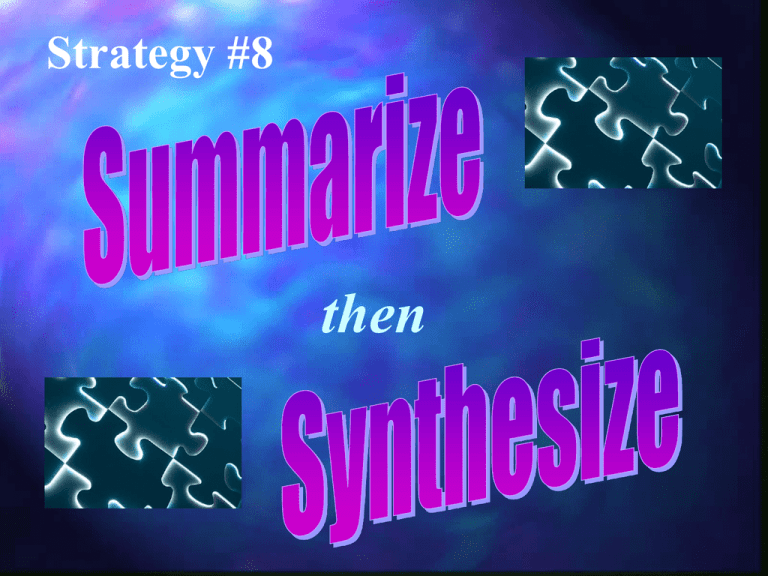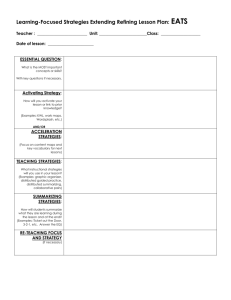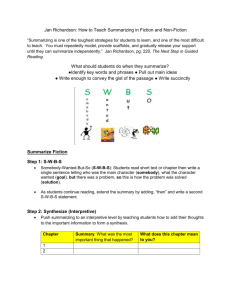Why summarize?
advertisement

Strategy #8 then Summarize Connect to the Text What do we already know? 1.What do you know about summarizing? What words come to mind? 2. How do you summarize? Summarize - to present the substance or general idea in brief form; to create a concise, condensed account of the original; to cover the main points Discuss -Why is summarizing important in your content area? What are the challenges in teaching it? Why summarize? “Practice in summarizing improves students’ reading comprehension of fiction and nonfiction alike, helping them construct an overall understanding of a text, story, chapter, or article.” (Rinehart, Stahl & Erickson, 1986) How Can I Teach My Students to Summarize? Newspaper Articles Short Text Internet Source Passage from Content Text Picture Books Be a News Reporter Who? What? When? Where? How? Why? Reciprocal Teaching The most important ideas in this text are… This book was about… First… Next… Then… Finally… This story takes place… The main characters are… The problem occurs when… Steps to identify the topic ~ Look at the title. Look at the first and last paragraph. Ask yourself: “What is discussed through the whole section?” Look at captions, pictures, words in bold, and headings for clues to the topic. What do they all have in common? Identify All Details/Major Events Authors often plant important ideas in: Details that reflect the title Details at the beginning of text Details at the end Surprises or revelations Repetitions Lots of attention given to a detail Subheads and italicized text Changes in character, tone, mood, setting, plot A question near the beginning or end Students Evaluate Summaries 1. If you have not read the text yourself, would you be able to understand what it was about from the summary? Why or why not? 2. Is there anything important that should be added? What is it? 3. Is there anything unimportant that should be be left out of the summary? What is it? Key word (s) Summarizing Key word (s) Summarizing First text chunk Fourth text chunk Title of Text to be Summarized Key word (s) Summarizing Key word (s) Summarizing Third text chunk Second text chunk Somebody/Wanted/But/So Then Reading Skills Important to Summarization • Conflict/Resolution • Character Differences, Goals, and Motivations • Main Ideas and Details • Making Generalizations Excerpt from The Necklace Mrs. Loisel wanted to be rich and wanted to go to the dance. BUT she didn’t have the right clothes and jewelry. SO she shamed her husband into buying her a dress and she borrowed a necklace. THEN Mrs. Loisel wanted to give back the necklace after she wore it. BUT she had lost it. SO she and her husband had to find a new one and THEN borrow money to buy it so she could return the replacement to her friend. Sum It Up! “She put on two woolen suits, one on top of the other. Then she put on two leather suits and covered her bulky outfit with a skirt.” Excerpt from Ruth Law Thrills a Nation (Brown, 1993) 3 – 2 – 1 Strategy 3 Things You Found Out 2 Interesting Facts 1 Question You Still Have Synthesize Connect to the Text Synthesis is… “The process of ordering, recalling, retelling, and recreating into a coherent whole the information with which our minds are bombarded every day. It is the uniquely human trait that permits us to sift through a myriad of details and focus on those pieces we need to know and remember.” (Keene/Zimmerman) SYNTHESIZE – Beyond Summary together The putting of parts or elements so as to form a whole Kids say… “Synthesizing is like inferring, only super-sized!” “When you “When I synthesize you say synthesize, my in your head, I used mind is changing, my to think this, but ideas are changing, my now I’m thinking is thinking this.” changing.” Bringing It home… “As families gather and share the events of the day, they are synthesizing, sorting out the unimportant, and creating individual interpretations of the day.” Keene, Zimmerman Synthesizing How is synthesizing important to your content area? 2. What are the challenges in teaching it? 1. Bloom’s Taxonomy Cues for Synthesis Combine Integrate Modify Rearrange Substitute Plan Create Design Invent Compose Construct Develop Organize Perform Produce Propose Rewrite Two-Word Strategy Read a thought-provoking article. Ask students to be silent and then to write only two different words that reflect their thinking about a passage. After selections, students should tell others the words, why they chose them, and how they relate to their lives. Strip Poem Each person writes one item that he/she knows about the subject studied. The strips of paper are read aloud in a small group. The group organizes itself in some coherent form. The group reads the “poem” to the class. Save the Last Word for Me Directions for Students: 1. Select a quote from the article you’ve read. Write your thought/ idea/question about the quote. 2. In a small group, give your quote and allow all others to respond. 3. At the end, share your comments. Character Hot Seat Ask student to sit in a chair in front of the room and assume a character from their book. Ask student various questions about his/her character’s life. Move to a higher level and ask his/her opinion on different subjects clearly important to that character. Reformulations ~ You can turn… …Poems into stories or letters …Expository text into narrative text …Diaries or memoirs into plays, newspaper articles, or television scripts …Texts into comic books, letters, or interviews Power Notes contribute to students’ awareness of text structure as they read and write. In addition ~ Students learn to read actively and to prioritize main ideas from details as they study. Power Notes can be integrated into a number of other activities to help students perceive how information is interconnected. Power 1 ~ main point or category Power 2’s, 3’s, and 4’s ~ corresponding details and examples An example of Power Notes 1. Penalties in Football 2. On Offense 3. Holding 3. Clipping 2. On Defense 3. Off Sides 3. Pass Interference 3. Grabbing Face Mask 2. On Special Teams Power 1 Power 2 Power 3 Power 3 Power 2 Power 3 Power 3 Don’t Forget to Model I do, you watch. I do, you help. You do, I watch. You do, I help. Proficient Readers Are… Aware of changes in their conclusions about text; actively revising meaning Monitoring the overall meaning and themes in text Aware of text elements in fiction: character, setting, and conflict/resolution Aware of text patterns in nonfiction Employing cause/effect, time order, and problem/solution Using their knowledge to make decisions about the overall knowledge Proficient Readers (After Reading) Can express, in a variety of means, ideas and themes relevant to the overall meaning of the text Create in an original way a sum of information from the text, from other texts, and their own ideas and opinions Use it to share, recommend, and CRITICALLY REVIEW the book “A mind stretched to a new idea never goes back to its original dimensions.” Oliver Wendell Holmes






